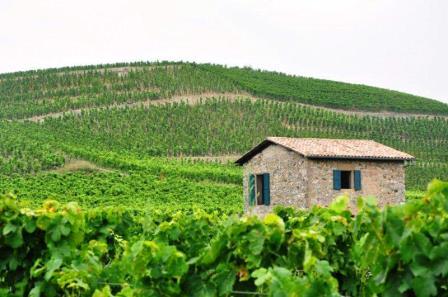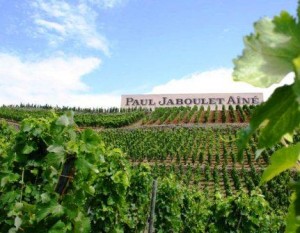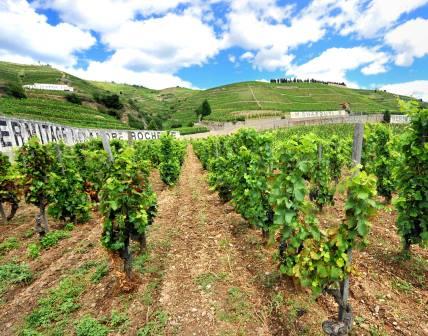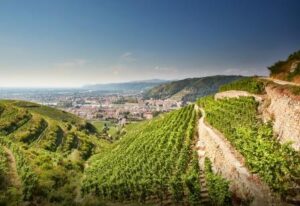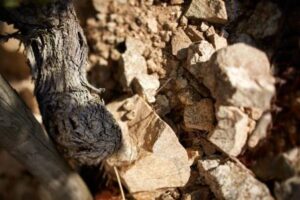The complete guide everything you need to know about Hermitage Wine
Learn everything about the Hermitage wine, the best wines, vineyards and best vintages with wine tasting notes, wine and food pairing tips, and histories of all the wine producers in Hermitage.
Hermitage wines are not much fun to drink young. But with the right amount of bottle age, Hermitage can be compared to any of the world’s great wines. Hermitage wines are full bodied, rich, tannic wines that can evolve for decades. In fact, these Northern Rhone wines often require 15-20 years before being ready drink, let alone mature. When young,
Hermitage is unformed, powerful, tannic, stern and even austere. On the nose you’ll find black fruits, herbs, olives, cassis, iron and earthy scents. The wines of Hermitage do not drink well young. Hermitage wines must be allowed time in the cellar to mature as they are the longest lived wines in the Northern Rhone
The magic of Hermitage wines begins when the wine matures, softens and comes together. The dark fruits shift to red. The nose takes on a perfume of earth, tobacco, sweet, fresh red and black fruits, olive tapenade and spice. The textures become soft, caressing your palate and the finish really lingers. The best red Hermitage wines can age for 20, 30, 40 or more years!
Hermitage Wine, Overview
Hermitage, which was at one time known as “Ermitage,” (Its original spelling) is a small appellation. The total size is about 130 hectares of vines. In a good vintage, the entire Hermitage appellation produces on average, close to 55,000 cases of wine per vintage.
Think about this… To illustrate the relative size of Hermitage, as a comparison, Chateau Lafite Rothschild in Pauillac is 100 hectares. Just north of Hermitage, its famous neighbor Cote Rote, is massive in comparison with a whopping 201 planted hectares! Hermitage unlike most wine regions is probably not going to increase in size or production either.
That is because the vineyard size of Hermitage is restricted by French law, and its very difficult, if not close to impossible to increase its size as the appellation has its natural boundaries that are set by the Hill of Hermitage. So, while all the other Northern Rhone appellations have expanded over the years, that has not happened in Hermitage.
The Hermitage appellation is located about 30 miles south of Cote Rotie, not far from the village of Tain l’Hermitage and close to 70 miles north of Chateauneuf du Pape. Hermitage is also on the east of the Rhone river, making it the only major Northern Rhone appellation that is not on the west of the Rhone.
Tain l’Hermitage is the town where all the negociants are located. It’s been the business district for all the Northern Rhone wine producers since the Ancient Romans occupied it, calling it, Tegna.
While the appellation of Hermitage is small, many of the best producers also make wine from nearby communes, such as; Crozes-Hermitage, Cornas, St. Peray and St. Joseph. The appellations of Crozes-Hermitage, Saint Joseph and Cornas can have similar terroirs to what you will find in Hermitage, although the exposures are quite different than what you find in Hermitage.
That is because most of the famous hillside vineyards in Hermitage enjoy a southern exposure, allowing the grapes the maximum amount of sun and warmth. It’s also interesting to note that the vineyard sizes in those neighboring appellations dwarfs that of Hermitage.
The famous “Hill of Hermitage,” which covers only 140 hectares was granted protected status by the French Government in 2013. The protected status is more than justified by the rich history and beauty of the region, with its steep, vineyard covered hills, crowned by the famous chapel of Saint Christopher. If you like visiting wine regions, The Hill of Hermitage is perhaps the most beautiful and imposing place you will ever visit.
Hermitage Wine Style and Character: Hermitage wines are rich, concentrated, tannic and offer scents of fresh black raspberries, blackberry, earth, spice, black cherry, minerals, olives and smoke. In their youth, they can deliver mouth searing tannins as well as show a stern, austere and even closed personality, making them difficult to taste, drink or enjoy when young.
When the wines age, Hermitage wines magically transform into elegant, refined, vibrant, rich, majestic, complex tasting experiences. Hermitage wines are among the longest lived wines in all of France. The best examples can age for for 20, 30, 40 or more years.
Top Ten Facts You Need to Know about Hermitage Wine
#1 Hermitage is the smallest major wine region in the Rhone Valley with only 130 planted hectares of vines.
#2 Hermitage only allows one red wine grape, Syrah, and two white wine grapes, Marsanne and Roussanne for use in the appellation.
#3 Hermitage was used for more than 100 years as part of the blend of Bordeaux and Burgundy to give body, tannin and color to the wines.
#4 Hermitage wine can be the longest lived wine in the entire Rhone Valley.
#5 Hermitage was originally known as Ermitage.
#6 Hermitage was first cultivated with vines in 600 BC.
#7 Jaboulet La Chapelle is the largest winery in Hermitage.
#8 In the 1800’s Hermitage was the most expensive and sought after wine in the world. At the time, the white wines were even more expensive than the red wines!
#9 While it is permitted for producers to add white wine grapes to their red wine, it is almost never done.
#10 The Chave family has been actively growing grapes since 1481! This makes the Chave family a serious contender for the oldest family in the world of wine.
The best vintages of Hermitage Wine 2016, 2015, 2012, 2010, 2009, 2005, 2003, 1999, 1998, 1995, 1990, 1989, 1988, 1985, 1982, 1978, 1966 and 1961. While most Northern Rhone appellations will produce similar levels of quality in the same vintage, that is not always the case. For example in 1991, a historic year of quality for Cote Rotie, Hermitage is not quite as successful.
More importantly, vintages in Hermitage and the Northern Rhone are not the same as you will find in Chateauneuf du Pape all the time. The regions can provide very different levels of quality in the same years. For example, 2003 is stunning in Hermitage, good, but mixed and producer dependent in Cote Rotie and the levels of quality range quite a bit in the Southern Rhone Valley. For more details on Hermitage and Northern Rhone vintages, please read our Hermitage and Northern Rhone Vintage Chart 1978 to Today
Perhaps the most famous wine ever produced in Hermitage is the perfect 1961 Jaboulet La Chapelle, which we rated a perfect 100 Pts. 1961 Jaboulet La Chapelle is a contender for the best red wine I have ever tasted.
The wine is also one of the world’s most costly wines as bottles have sold at auction for over $15,000 per bottle, making it the most expensive wine in the history of the Rhone Valley! For current vintages, by far, the priciest Hermitage wine comes from JL Chave, which produces Cuvee Cathelin, a wine that easily sells for more than $2,000 per bottle!
For the best value in Hermitage wine with some bottle age, that offer a good price to quality ratio, look for wines from 1994, 1995, 1997, 1998, 2001 and 2003. I love Hermitage from 2003, but the vintage is not for everyone, due to the intense levels of concentration, incredible opulent textures and its exotic personality.
Those previously listed vintages tend to sell for under their true level of quality. For the best Hermitage value wines, there is also a massive cooperative located in Tain l’Hermitage, “Cave de Tain.” Cave de Tain, underwent a very expensive, complete renovation that cost more than 10 Million Euros. The cooperative which has been producing wine for close to 100 years, finished their renovations in 2014.
Hermitage wine and food pairings: Hermitage wine with food makes for great and versatile wine and food matches, especially with strong, hardy courses. Grilled beef, lamb, veal and pork, chicken, game, duck, stews, braised foods and fish dishes are all great pairings. The addition of bacon is perfect for Hermitage as it creates a natural aromatic, wine and food match. Hermitage wine can also pair well with a myriad of hard and soft cheeses.
For the white Hermitage wine and pairings, due to its thick, often rich, oily qualities and concentration, cream dishes, buttery courses make excellent wine and food matches. Shellfish, lobster, crab, roasted, seabass, monk fish, mussels, grilled or seared fish, crudo, sushi and even lighter meats like chicken, veal, pork and cheeses make great pairings. Spicy, Asian cuisine also works for wine and food matches with Hermitage Blanc wines. White Hermitage wine is perfect with a wide variety of cheeses.
History of Hermitage: Hermitage is one of the older wine growing areas in the world. The Ancient Greeks planted vines in about 600 BC. The Romans also planted vines in the region when they used it as an outpost for Lyon. At the time, it was known as Tegna. It is thought that the first plantings of what we know of as Syrah today were used in the vineyards of Hermitage.
The region eventually changed its name to Hermitage at some point during the 17th century. This was done to honor and remember Henri Gaspard de Sterimberg, a Knight now famous for cultivating the region and living out his days as a hermit, on the hill of Hermitage. Hermitage is loosely translated into hermit. Henri Gaspard de Sterimberg is of course also celebrated by Jaboulet, who has named a red and white name in his honor.
By the 1600’s, Hermitage became the official wine of King Louis XIII. The next in line for the throne, Louis XIV, the Sun King, continued the tradition of drinking the wine of Hermitage. Demand continued to grow for the wines of Hermitage during the 18th century.
By the early 1700’s the wines of Hermitage were already being exported to England. In fact, during the 1700’s, the best wines of Hermitage sold for as much, or more money than the First Growth wines of Bordeaux! Hermitage was one of the favorite wines of Thomas Jefferson, the third President of the United States who wrote detailed comments on the wines from region.
By this time, Hermitage, like Bordeaux was being settled by royalty, which helped the wines gain fame. Shortly after the French Revolution, when many properties were confiscated, wealthy gentry along with former members of royal families began populating the region. Reminders of the early royal founding families of Hermitage are found on wine labels today including Marquis, de la Tourette and Monier de la Siveranne. The first important negociant firm in the Northern Rhone was founded in in 1793 by Charles Jourdan.
Demand for individual brands might have started in Hermitage as early as 1862, when Domaine Bergier, perhaps the most famous producer of the era, put up a massive wood sign on the peak of their vineyards proclaiming “Hermitage, Cuvee Bergier.” It was during this time, give or take, that the biggest negociants in the region began to open their business, Chapoutier, Jaboulet and Delas.
When the wines of Hermitage were exported, the route taken always traveled through Bordeaux. Clearly, this brought the level of quality wine being produced in Hermitage to the attention of the Bordelais and other influential people of their day.
In fact, Hermitage was so respected, some negociants and Bordeaux chateaux added Syrah from Hermitage to their wines, to give them more backbone, strength, color and vigor. While some of this blending was done behind closed doors, there were labels from some negociants proudly boasting of the blend made from Hermitage and Bordeaux. There were negociant offerings to clients allowing for Bordeaux plus, which was a blending of various percentages of Hermitage and Bordeaux.
Many Burgundy producers also included a portion of Syrah from Hermitage to add structure and color to their wine as well. The trade between Bordeaux and Hermitage was important enough to encourage the Rhone negociant, Calvet open offices in Bordeaux. The practice of adding Hermitage to Bordeaux continued for over a century. It was forever halted after the vineyards of Hermitage, along with most European wine regions were devastated by Phylloxera.
Today the practice of blending wine from various regions has been forbidden by AOC law. However, a few producers, most notably Jaboulet makes a small amount of wine from a blend of Hermitage and Bordeaux grapes, which is sold as a Vin de France as does Chateau Palmer in Margaux.
It was Phylloxera that ruined Hermitage for decades. This started in 1874. However, the recovery from Phylloxera is what allowed for the creation of the appellation that is close to what we have in the Hermitage region today. It took almost until the start of the 20th century, before Hermitage was once again a prosperous wine region.
Hermitage, The Modern Era
World War 1, as you might expect dealt another blow to the appellation. To give you an idea, in a region dominated by negociants, from the end of World War 1 until the start of the depression, only 4 negociants remained in business in the region. Hermitage did not become a fully active wine region until the 1970’s.
It’s important to remember that until recently, very few growers produced, bottled and sold their own wine in Hermitage. The few domaines that made their own, often bottled on demand, so there could be a big difference between the wines bottled first, and those that were the last wines bottled from the barrels. That is no longer the case today. The majority of wines coming from Hermitage were negociant bottling as recent as the 1970’s and 1980’s.
Since the 1990’s more growers have started producing their own wine. Other recent trends have more producers making single vineyard wines, parcel selections and producing wines from their oldest vines. The number of single vineyard wines continues to grow. However, single vineyard wines are not an entirely new even in Hermitage.
In fact, Chapoutier produced at least one vintage of a Bessards in 1955. Across the board today, producers are striving to pick phenolically ripe grapes and produce wines from lower yields. In the vineyards, more growers are practicing self sustaining farming, organic or biodynamic vineyard management. All those actions have helped the wines of Hermitage continue improving its wines and increasing their demand and popularity in the world marketplace.
Hermitage Grapes and Vineyards: The only red wine grape allowed by AOC law to be planted in Hermitage is Syrah. Marsanne and Roussanne are the only two white wine grapes allowed to be planted in the appellation as well. While it’s legal to add white wine grapes into the blend for the red wine of Hermitage, similar to what they do in Cote Rotie with Viognier, it is not a common practice in the Hermitage appellation.
AOC law permits a maximum of 15% of the blend to include white wine grape varietals. However, most producers that include Marsanne use at most 5% of the variety in the blend. The more common use for Roussanne and Marsanne in Hermitage is to produce dry, white wines. More than 93% of all wines produced in Hermitage are red wine.
Hermitage is small. No, make that tiny with only 130 planted hectares. The size has remained relatively constant over the years. The famous hill of Hermitage occupies the peak of the appellation at 344 meters in height. It is on the hill where you find the best vineyards in the appellation.
Hermitage Terroir and Soils: The best vineyards of Hermitage are located on the steep, rocky hillsides on the hill of Hermitage, which rises to 344 meters at its peak in the Les Bessards climat. In Hermitage, the term climat can be used instead of lieu-dit. Both terms are translated to mean a recognized vineyard.There are three main hills in the appellation that share the famous, steep, rock strewn terroir.
This can be looked at from vineyards planted in the east and in the west. The terroir of Hermitage consists of granite, various stones, limestone, iron, sand, quartz and clay soils. In the East, you find more brown stones, rocks and clay along with granite. The eastern side of the hill was shaped by the Alps. In the west, you find more granite, as well as larger deposits of limestone, clay, sand and alluvium in the soil that was shaped by the Massif Central. But it is really the granite and decomposing granite that gives the wine of Hermitage its signature character and style.
The variety of rocks and stones help to drain excess moisture while radiating heat and sunshine, which assists the grapes in reaching their desired level of ripeness. The rocky terrain also forces the vines to dig deep into the soils, seeking nourishment. While there are as you can see, differences between the soils and terroirs on the east and west sides of the Hermitage hills, it is often the blending of the terroirs that create Hermitage wine.
However, it’s important to note that one of the interesting aspects of the terroir and soil types here is that is it can change quite quickly, even inside of the same vineyard. In Hermitage, the best wines come from the steep hillside plantings.
The hill slopes and before it hits the bottom flats, there are small, terraces or steps you encounter before you reach the base, that relatively flat. The flats have an east/west exposure while the hillsides enjoys the warmer, sunnier, and drier southern exposure. That being said, the hillsides are where all the best vineyards are planted. The top wines of Hermitage are produced from vines planted in “L’Hermite” and “La Chapelle,” both of which are located on the peak of the Hermitage hill.
“Les Bessards,” which is in the western part of the appellation and the vineyards in the eastern portion of the appellation which include; “Le Meal,” “Les Greffieux,” “Bessards” and “Murets” are also among the most prized vineyard sites. There are numerous vineyards in Hermitage, which are known as climats.
Those vineyards or climats are the main source for grapes used to produce JL Chave, Jaboulet La Chapelle and Chapoutier, as well as the other top estates in the region. Not all Hermitage vineyards are located on the hills Some are on the slopes. As you travel further down the slopes you find more sand, rocks and alluvium in the vineyard soils.
Even though Hermitage is produced with only one red grape, Syrah, the blending of the grape sources provide a lot of complexity to the wines. This is needed in Hermitage, because each of the different vineyards brings something different to the blend, due to the various different soil types, exposures and even the various levels of of pH in the soils.
Producers like JL Chave blends grapes from 7 different vineyards to produce Chave Hermitage! It’s interesting that the vine densities in the best vineyards vary according to elevations. For example, at some elevations you find plantings of 10,000 vines per hectare, for example on Les Bessards.
Further down the slopes, vineyards are planted to 7,000 vines per hectare. As you might expect, while the top of the hills feature massive amounts of granite, as you travel further down the slopes, the terroir and soils shifts, to more loose rocks, stones and clay.
Les Bessards is the most famous, as well as the largest vineyard in Hermitage. Some of the best vines in the entire appellation are planted in Les Bessards. Chave, Jaboulet, Chapoutier and Delas all have vines planted in Les Bessards. The vineyard can be broken into 2 other sections, Grands Bessards, which is hard granite with rocks and stones on the surface.
Petits Bessads is at the lowest elevation of the three sections. Bessards has a bit more clay, along with the granite. The majority of Les Bessards is planted to Syrah, but in the cooler soils, close to the bottom the vineyard, you find a small amount of Marsanne planted.
Le Meal is the next most famous vineyard on Hermitage, it’s placed just east of Les Bessards. You find a lot of hard granite, various rocks, stones, clay, sand and limestone. The vineyard is curved in shape and has some of the sharpest inclines in the appellation.
There are no terraces here. It’s a naturally warm terroir. Jaboulet is the largest landholder here. major Mostly Syrah is planted here, but there are some white wine grapes planted in Le Meal as well. Due to its warm microclimate, it’s often one of the first major vineyards to be picked.
L’Hermite is packed with various types of granite, some of which is decomposing coupled with loess, rocks and stones of various shapes and sizes and clay. Red and white wine grapes are planted here. Chapoutier, Chave and Guigal own vines here.
Le Greffieux has a terroir of granite, clay, stones of different sizes and limestone soils. The vast majority of Le Greffieux is planted to Syrah. Chave, Marc Sorrel and Chapoutier all have vines planted here. The site is placed just under Le Meal and next to Bessards.
Some of the other Hermitage vineyards are: Beaumes, La Croix,Les Diognieres, Diognieres et Torras, L’Homme, Maison Blanche, Murets, Les Plantiers, Peleat, La Pierrelle, Roucoules, Torras et les Garennes,
Hermitage is a very labor intensive appellation to farm and harvest. Due to the steep inclines, much of the works need to be done by people and horses. Organic farming techniques and biodynamic vineyard practices continue to expand and gain in popularity in the Hermitage appellation. Credit for bringing the full attention to biodynamic farming to Hermitage belongs to Michel Chapoutier.
The Climate and Weather in Hermitage. Hermitage enjoys a more temperate climate than the rest of the Rhone Valley, due to its location in the northern part of the appellation. On average, Hermitage obtains of 2,100 hours of sunshine per growing season. It rains close to 800 millimeters, (31″) per year. Hermitage is perhaps the warmest appellation in the Northern Rhone.
The winds blowing through Hermitage are called La Bise. The wines head into the region from the north. Much of the ferocity of the wind is abated, due to the shape and structure of The Hill of Hermitage. The only vineyards that endure more of the winds force are located on the top of the plateau in the L’Homme, Maison Blanche and Varogne lieux-dits.
The wind is another important factor in the terroir, as it helps to keep the grapes and vines clean and as disease free as possible. Interestingly, the winds in the north usually follow the rains, which is quite useful, as that can remove moisture. This is the opposite of what takes place in the south, when the winds usually foreshadow the rain.
Production and wine making in Hermitages: When to harvest will determine the desired character for the wine, based on its degrees of phenolic ripeness. The removal of stems is a major decision. Each property does things differently. There is no hard and fast rule.
There are estates that remove 100% of their stems, while other winemakers only remove a portion of their stems. Today, the trend at estates desiring softer wines and rounder tannins is to destem, all, or part of their harvest, especially in less that optimally ripe vintages. Once that has taken place, the winemaker decides on whether to ferment using whole bunches or not.
The vessel used for the vinification varies from property to property. Some estates like Chapoutier prefer open top, large oak fermenters. Others use concrete tanks like Jaboulet, who also use stainless steel tanks. Stainless steel is favored by Chave.
Syrah is the only allowable red wine grape in Hermitage. Producers can include as much as 15% Marsanne or Roussanne in their blend, but almost no wineries use even 5% of the white wine grape variety in the blend. The more common use for Marsanne is on its own as a 100% white wine varietal, or blended with Roussanne to produce dry, white Hermitage wines. It is legal, and easier for the producers to co ferment red and white wine grapes together, should they wish to make blend.
For the aging of Hermitage wine, using a lot of new, French oak barrels is not popular in the region. Of course there are exceptions. Chapoutier uses almost 100% new, French oak barrels. Guigal, with Ex Voto is another stunning wine that prefers utilizing a lot of new, French barrels as does Jaboulet with La Chapelle.
But most domaines in Hermitage employ 30% or less new oak barrels when aging their wine. There are also estates that age their wine in large, oak casks and demi-muids. The time in barrel is another important factor to consider when looking at how an estate ages their wine. While it was common practice to age Hermitage wine for two years and longer in the 1970’s, and even bottle their wine on demand as it was purchased by customers, today, most wineries prefer closer to 18 months or less.
For the production of Hermitage Blanc, grapes are fermented most often in cask. Although some producers use a combination of cask and stainless steel vats to produce their white Hermitage wine. Malolactic fermentation takes place in cask, and or stainless steel vats.
The amount of new, French oak for the vinification and aging period varies depending on the estate. It can range from an average of 30% new oak to 75% new oak barrels. Hermitage white wines are usually aged on their lees for between 8 to 12 months before bottling. While the majority of Hermitage estates produce wine from 100% Marsanne, other winemakers prefer adding Roussanne as a part of the blend. But even when the wines are blended, in almost every case, the majority of the blend is Marsanne.
Hermitage wines are also produced in very tiny amounts. JL Chave with 2,000 cases and Jaboulet with 7,000 cases are the regions largest and thus most dominant wineries. For the rest of the region, most Hermitage wine makers produce on average under 500 cases per vintage for the entire world! Perhaps, due to its small size, not many producers make vineyard specific Hermitage wines.
But today, there is a growing trend for the production of single vineyard wines, or special cuvee’s than at any time in history. Hermitage wines, due to their small production are often difficult to find and expensive in older vintages.
Vin de Paille in Hermitage: Aside from red Hermitage wine and Hermitage blanc, a few domaines also produce Vin de Paille, a sweet Hermitage wine made from Marsanne and Roussanne grapes dried on straw mats. The wine is incredibly dense, as it takes up to 8 kilograms, 17.5 pounds of grapes to make a single bottle of wine!
The grapes take a minimum of 45 days to dry. The wines are always aged in 100% new, French oak barrels. Hermitage Vin de Paille can take years to ferment dry, In some vintages, JL Chave has allowed the wine to remain in barrel fermenting for up to 7 years before bottling. Hermitage Vin de Paille retains on average 150 grams of sugar per liter, although in very ripe vintages, that can increase to 170 grams of sugar per liter.
The wine can easily age for decades. Vin de Paille is almost always made in half bottles, or 375 ml. The two most famous producers making Vin de Paille in Hermitage are Chave and Chapoutier. Vin de Paille takes its name from the method of production as paille is translated from French to straw, thus the wine is naturally called a straw wine.

